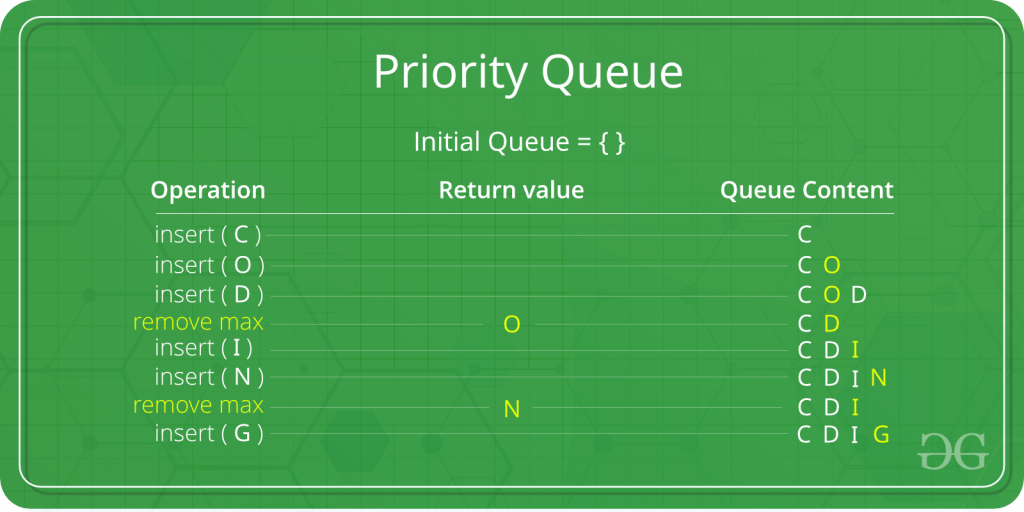Introduction
In the realm of data structures, understanding the differences and use cases of various types is crucial for efficient algorithm design and problem-solving. Two such important data structures are the priority queue and the circular queue. This article delves into a comprehensive comparison of these two data structures, focusing on their key differences and use cases.
Priority Queue in Data Structure
A priority queue is a special type of queue where each element is associated with a priority. Elements are served based on their priority, rather than their position in the queue. The element with the highest priority is dequeued first. If two elements have the same priority, they are served according to their order in the queue.
Key Characteristics
-
Ordering: Elements are ordered based on priority.
-
Heap Implementation: Often implemented using binary heaps to achieve efficient insertions and deletions.
-
Applications: Widely used in scheduling algorithms, network routing algorithms, and other scenarios where priority is a factor.
Use Cases
-
Task Scheduling: Operating systems use priority queues to manage process scheduling, ensuring that higher-priority processes are executed first.
-
Dijkstra’s Algorithm: This shortest path algorithm utilizes a priority queue to efficiently determine the closest node.
-
Event-Driven Simulations: Events are processed based on their scheduled times, which are managed using a priority queue.
Circular Queue in Data Structure
A circular queue, also known as a circular buffer, is a linear data structure that follows the First In First Out (FIFO) principle. Unlike a regular queue, the last position is connected back to the first position to make a circle. This circular nature allows for efficient use of memory by reusing vacated spaces.
Key Characteristics
-
Fixed Size: Circular queues are of a fixed size.
-
Memory Utilization: Efficient in memory usage since it can overwrite old data when the buffer is full.
-
Applications: Commonly used in buffering data streams, handling asynchronous data transfer, and implementing fixed-size storage.
Use Cases
-
Buffering Data Streams: Circular queues are ideal for buffering data streams in real-time systems, such as audio and video streaming.
-
Resource Management: Useful in managing resources like CPU scheduling where tasks need to be cyclically processed.
-
Asynchronous Data Transfer: Employed in scenarios where data needs to be transferred asynchronously, ensuring that old data can be overwritten without data loss.
Key Differences and Use Cases
Understanding the key differences between priority queues and circular queues is essential for selecting the right data structure for specific applications. Here are the primary distinctions and their respective use cases:
-
Ordering Mechanism:
-
Priority Queue: Elements are ordered based on priority. The element with the highest priority is dequeued first.
-
Circular Queue: Elements follow the FIFO principle, and the order is maintained cyclically.
-
-
Implementation:
-
Priority Queue: Often implemented using binary heaps for efficient priority management.
-
Circular Queue: Implemented using arrays or linked lists with pointers wrapping around to the beginning when the end is reached.
-
-
Use Cases:
-
Priority Queue: Ideal for applications where the order of processing is based on priority, such as task scheduling and shortest path algorithms.
-
Circular Queue: Best suited for scenarios requiring efficient memory use and cyclic processing, such as data buffering and resource management.
-
-
Memory Utilization:
-
Priority Queue: Generally uses dynamic memory allocation as elements are added or removed based on priority.
-
Circular Queue: Uses fixed-size memory, making it efficient for scenarios where a predictable amount of memory is required.
-
Conclusion
In data structures, choosing between a priority queue and a circular queue depends largely on the specific requirements of the application. Priority queues excel in scenarios where prioritization is crucial, such as in scheduling and routing algorithms. In contrast, circular queues are highly efficient for applications requiring fixed-size memory and cyclic processing, such as data buffering and resource management.
By understanding the key differences and use cases of priority queues and circular queues, developers can make informed decisions that optimize performance and resource utilization in their systems. Whether you need to manage priorities or handle cyclic data efficiently, each of these data structures offers unique advantages tailored to specific needs in the world of data structures.

